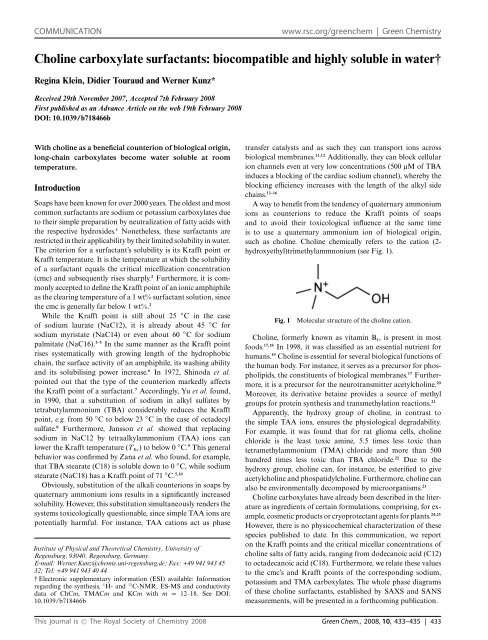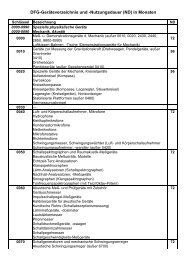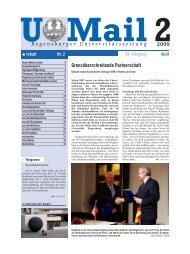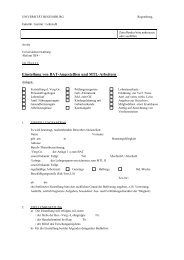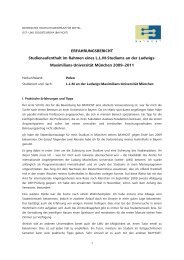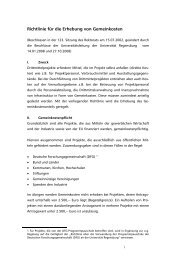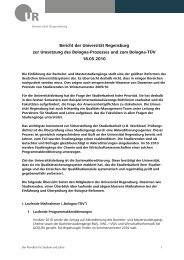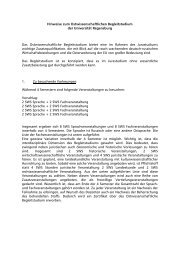Choline carboxylate surfactants: biocompatible and highly soluble in ...
Choline carboxylate surfactants: biocompatible and highly soluble in ...
Choline carboxylate surfactants: biocompatible and highly soluble in ...
Create successful ePaper yourself
Turn your PDF publications into a flip-book with our unique Google optimized e-Paper software.
COMMUNICATION www.rsc.org/greenchem | Green Chemistry<br />
<strong>Chol<strong>in</strong>e</strong> <strong>carboxylate</strong> <strong>surfactants</strong>: <strong>biocompatible</strong> <strong>and</strong> <strong>highly</strong> <strong>soluble</strong> <strong>in</strong> water†<br />
Reg<strong>in</strong>a Kle<strong>in</strong>, Didier Touraud <strong>and</strong> Werner Kunz*<br />
Received 29th November 2007, Accepted 7th February 2008<br />
First published as an Advance Article on the web 19th February 2008<br />
DOI: 10.1039/b718466b<br />
With chol<strong>in</strong>e as a beneficial counterion of biological orig<strong>in</strong>,<br />
long-cha<strong>in</strong> <strong>carboxylate</strong>s become water <strong>soluble</strong> at room<br />
temperature.<br />
Introduction<br />
Soaps have been known for over 2000 years. The oldest <strong>and</strong> most<br />
common <strong>surfactants</strong> are sodium or potassium <strong>carboxylate</strong>s due<br />
to their simple preparation by neutralization of fatty acids with<br />
the respective hydroxides. 1 Nonetheless, these <strong>surfactants</strong> are<br />
restricted <strong>in</strong> their applicability by their limited solubility <strong>in</strong> water.<br />
The criterion for a surfactant’s solubility is its Krafft po<strong>in</strong>t or<br />
Krafft temperature. It is the temperature at which the solubility<br />
of a surfactant equals the critical micellization concentration<br />
(cmc) <strong>and</strong> subsequently rises sharply. 2 Furthermore, it is commonly<br />
accepted to def<strong>in</strong>e the Krafft po<strong>in</strong>t of an ionic amphiphile<br />
as the clear<strong>in</strong>g temperature of a 1 wt% surfactant solution, s<strong>in</strong>ce<br />
the cmc is generally far below 1 wt%. 2<br />
While the Krafft po<strong>in</strong>t is still about 25 ◦ C <strong>in</strong> the case<br />
of sodium laurate (NaC12), it is already about 45 ◦ C for<br />
sodium myristate (NaC14) or even about 60 ◦ C for sodium<br />
palmitate (NaC16). 3–5 In the same manner as the Krafft po<strong>in</strong>t<br />
rises systematically with grow<strong>in</strong>g length of the hydrophobic<br />
cha<strong>in</strong>, the surface activity of an amphiphile, its wash<strong>in</strong>g ability<br />
<strong>and</strong> its solubilis<strong>in</strong>g power <strong>in</strong>crease. 6 In 1972, Sh<strong>in</strong>oda et al.<br />
po<strong>in</strong>ted out that the type of the counterion markedly affects<br />
the Krafft po<strong>in</strong>t of a surfactant. 7 Accord<strong>in</strong>gly, Yu et al. found,<br />
<strong>in</strong> 1990, that a substitution of sodium <strong>in</strong> alkyl sulfates by<br />
tetrabutylammonium (TBA) considerably reduces the Krafft<br />
po<strong>in</strong>t, e.g. from 50 ◦ Ctobelow23 ◦ C <strong>in</strong> the case of octadecyl<br />
sulfate. 8 Furthermore, Jansson et al. showed that replac<strong>in</strong>g<br />
sodium <strong>in</strong> NaC12 by tetraalkylammonium (TAA) ions can<br />
lower the Krafft temperature (T Kr)tobelow0 ◦ C. 9 This general<br />
behavior was confirmed by Zana et al. who found, for example,<br />
that TBA stearate (C18) is <strong>soluble</strong> down to 0 ◦ C, while sodium<br />
stearate (NaC18) has a Krafft po<strong>in</strong>t of 71 ◦ C. 5,10<br />
Obviously, substitution of the alkali counterions <strong>in</strong> soaps by<br />
quaternary ammonium ions results <strong>in</strong> a significantly <strong>in</strong>creased<br />
solubility. However, this substitution simultaneously renders the<br />
systems toxicologically questionable, s<strong>in</strong>ce simple TAA ions are<br />
potentially harmful. For <strong>in</strong>stance, TAA cations act as phase<br />
Institute of Physical <strong>and</strong> Theoretical Chemistry, University of<br />
Regensburg, 93040, Regensburg, Germany.<br />
E-mail: Werner.Kunz@chemie.uni-regensburg.de; Fax: +49 941 943 45<br />
32; Tel: +49 941 943 40 44<br />
† Electronic supplementary <strong>in</strong>formation (ESI) available: Information<br />
regard<strong>in</strong>g the synthesis, 1 H- <strong>and</strong> 13 C-NMR, ES-MS <strong>and</strong> conductivity<br />
data of ChCm, TMACm <strong>and</strong> KCm with m = 12–18. See DOI:<br />
10.1039/b718466b<br />
transfer catalysts <strong>and</strong> as such they can transport ions across<br />
biological membranes. 11,12 Additionally, they can block cellular<br />
ion channels even at very low concentrations (500 lM ofTBA<br />
<strong>in</strong>duces a block<strong>in</strong>g of the cardiac sodium channel), whereby the<br />
block<strong>in</strong>g efficiency <strong>in</strong>creases with the length of the alkyl side<br />
cha<strong>in</strong>s. 13–16<br />
A way to benefit from the tendency of quaternary ammonium<br />
ions as counterions to reduce the Krafft po<strong>in</strong>ts of soaps<br />
<strong>and</strong> to avoid their toxicological <strong>in</strong>fluence at the same time<br />
is to use a quaternary ammonium ion of biological orig<strong>in</strong>,<br />
such as chol<strong>in</strong>e. <strong>Chol<strong>in</strong>e</strong> chemically refers to the cation (2hydroxyethyl)trimethylammnonium<br />
(see Fig. 1).<br />
Fig. 1 Molecular structure of the chol<strong>in</strong>e cation.<br />
<strong>Chol<strong>in</strong>e</strong>, formerly known as vitam<strong>in</strong> B 4, is present <strong>in</strong> most<br />
foods. 17,18 In 1998, it was classified as an essential nutrient for<br />
humans. 19 <strong>Chol<strong>in</strong>e</strong> is essential for several biological functions of<br />
the human body. For <strong>in</strong>stance, it serves as a precursor for phospholipids,<br />
the constituents of biological membranes. 17 Furthermore,<br />
it is a precursor for the neurotransmitter acetylchol<strong>in</strong>e. 20<br />
Moreover, its derivative beta<strong>in</strong>e provides a source of methyl<br />
groups for prote<strong>in</strong> synthesis <strong>and</strong> transmethylation reactions. 21<br />
Apparently, the hydroxy group of chol<strong>in</strong>e, <strong>in</strong> contrast to<br />
the simple TAA ions, ensures the physiological degradability.<br />
For example, it was found that for rat glioma cells, chol<strong>in</strong>e<br />
chloride is the least toxic am<strong>in</strong>e, 5.5 times less toxic than<br />
tetramethylammonium (TMA) chloride <strong>and</strong> more than 500<br />
hundred times less toxic than TBA chloride. 22 Due to the<br />
hydroxy group, chol<strong>in</strong>e can, for <strong>in</strong>stance, be esterified to give<br />
acetylchol<strong>in</strong>e <strong>and</strong> phospatidylchol<strong>in</strong>e. Furthermore, chol<strong>in</strong>e can<br />
also be environmentally decomposed by microorganisms. 23<br />
<strong>Chol<strong>in</strong>e</strong> <strong>carboxylate</strong>s have already been described <strong>in</strong> the literature<br />
as <strong>in</strong>gredients of certa<strong>in</strong> formulations, compris<strong>in</strong>g, for example,<br />
cosmetic products or cryoprotectant agents for plants. 24,25<br />
However, there is no physicochemical characterization of these<br />
species published to date. In this communication, we report<br />
on the Krafft po<strong>in</strong>ts <strong>and</strong> the critical micellar concentrations of<br />
chol<strong>in</strong>e salts of fatty acids, rang<strong>in</strong>g from dodecanoic acid (C12)<br />
to octadecanoic acid (C18). Furthermore, we relate these values<br />
to the cmc’s <strong>and</strong> Krafft po<strong>in</strong>ts of the correspond<strong>in</strong>g sodium,<br />
potassium <strong>and</strong> TMA <strong>carboxylate</strong>s. The whole phase diagrams<br />
of these chol<strong>in</strong>e <strong>surfactants</strong>, established by SAXS <strong>and</strong> SANS<br />
measurements, will be presented <strong>in</strong> a forthcom<strong>in</strong>g publication.<br />
This journal is © The Royal Society of Chemistry 2008 Green Chem., 2008, 10, 433–435 | 433
Experimental data about synthesis, analysis <strong>and</strong> characterisation<br />
of chol<strong>in</strong>e <strong>carboxylate</strong>s (ChCm), potassium <strong>carboxylate</strong>s<br />
(KCm) <strong>and</strong> TMA <strong>carboxylate</strong>s (TMACm) with m = 12–18 can<br />
be found <strong>in</strong> the ESI.†<br />
Results <strong>and</strong> discussion<br />
Critical micellization concentration (cmc)<br />
In Table 1, the values of the cmc’s for the <strong>in</strong>vestigated chol<strong>in</strong>e<br />
<strong>surfactants</strong> are compared with those of the related sodium<br />
<strong>and</strong> potassium <strong>carboxylate</strong>s. Apparently, the cmc’s of chol<strong>in</strong>e<br />
<strong>carboxylate</strong>s are <strong>in</strong> the same order of magnitude as those of<br />
the alkali soaps. Moreover, the cmc of ChC12 co<strong>in</strong>cides nearly<br />
exactly with that of TMAC12 (cmc = 25 mM), 9 <strong>in</strong>dicat<strong>in</strong>g that<br />
the hydroxy group of chol<strong>in</strong>e does not <strong>in</strong>fluence noticeably the<br />
micelle formation.<br />
Furthermore, the cmc of ChCm decreases l<strong>in</strong>early by a factor<br />
of 4 per addition of two CH 2 groups. This feature, typical<br />
for ionic amphiphiles, can be illustrated by eqn (1), where the<br />
logarithm of the cmc is a l<strong>in</strong>ear function of the alkyl cha<strong>in</strong> length<br />
n C. 28<br />
log cmc = An C + B (1)<br />
For mono-ionic <strong>surfactants</strong>, the constant A typically adopts<br />
the value 0.3, 29 which is <strong>in</strong> good agreement with that found for<br />
the <strong>in</strong>vestigated <strong>surfactants</strong> (0.29). The parameter B (1.9) is a<br />
constant for a particular ionic head at a given temperature <strong>and</strong><br />
corresponds well to that found <strong>in</strong> the literature for potassium<br />
<strong>carboxylate</strong>s (1.9). 29<br />
From the values of the cmc’s, it can be deduced that chol<strong>in</strong>e<br />
<strong>carboxylate</strong>s at low concentrations generally act <strong>in</strong> the same<br />
manner as the alkali <strong>carboxylate</strong>s <strong>in</strong> aqueous solutions. S<strong>in</strong>ce,<br />
for <strong>in</strong>stance, the sodium salts are completely dissociated <strong>in</strong> dilute<br />
solution, 26 thechol<strong>in</strong>esaltscanalsobeassumedtorevealno<br />
association of the carboxylic headgroup with the counterion<br />
chol<strong>in</strong>e. In contrast, the TAA salts of sulfates exhibit a precmc<br />
ion-pair<strong>in</strong>g. 30 Accord<strong>in</strong>gly, the cmc values of TAA sulfates<br />
(e.g. cmc (TMA dodecyl sulfate) = 5.53 mM) are reduced <strong>in</strong><br />
comparison to the correspond<strong>in</strong>g alkali sulfates (e.g. cmc (Na<br />
dodecyl sulfate) = 8.32 mM). 30<br />
Nonetheless, the most outst<strong>and</strong><strong>in</strong>g property of these chol<strong>in</strong>e<br />
salts is the fact that they are capable of form<strong>in</strong>g micelles at<br />
room temperature even with palmitic acid (C16)—<strong>in</strong> contrast<br />
to the homologous alkali soaps, which are restricted <strong>in</strong> their<br />
solubility. As a consequence of the potential use of longer-cha<strong>in</strong><br />
<strong>surfactants</strong>, a relatively high surface tension reduction down to<br />
about 25 mN m −1 for ChC16 can be obta<strong>in</strong>ed. 31<br />
Table 1 Comparison of the cmc’s [mM] of chol<strong>in</strong>e, sodium <strong>and</strong><br />
potassium <strong>carboxylate</strong>s at 25 ◦ C<br />
<strong>Chol<strong>in</strong>e</strong> Sodium Potassium<br />
C12 25.5 24.4 a 25.5 b<br />
C14 6.4 6.9 a 6.6 b<br />
C16 1.8 — —<br />
a From ref. 26. b From ref. 27.<br />
Krafft po<strong>in</strong>t<br />
The Krafft po<strong>in</strong>t of a surfactant is the result of the <strong>in</strong>terplay<br />
between two compet<strong>in</strong>g thermodynamic forces. One is the<br />
free energy of the solid crystall<strong>in</strong>e state <strong>and</strong> the other is the<br />
free energy of the micellar solution. A strong head group<br />
<strong>in</strong>teraction <strong>and</strong> a good pack<strong>in</strong>g <strong>in</strong> a crystal lattice contribute<br />
to the crystal’s stability, which is associated with a low free<br />
energy. Consequently, the Krafft po<strong>in</strong>t is elevated. In turn, a<br />
low free energy of the micellar solution, promoted by e.g. the<br />
hydrophilicity of a compound, favours the solubilised state.<br />
However, the energetic state of the micellar solution varies only<br />
slightly when chang<strong>in</strong>g the counterion, whereas the free energy<br />
of the crystall<strong>in</strong>e state may change considerably from system to<br />
system. 32 Hence, the latter contribution can be considered as the<br />
ma<strong>in</strong> driv<strong>in</strong>g force <strong>in</strong> determ<strong>in</strong><strong>in</strong>g the solubilisation temperature.<br />
In Fig. 2, the Krafft temperatures for ChCm,TMACm,KCm<br />
<strong>and</strong> NaCm with m = 12–18 are shown. The values, which<br />
we determ<strong>in</strong>ed for the potassium <strong>carboxylate</strong>s are generally <strong>in</strong><br />
good agreement with those found by McBa<strong>in</strong> et al. 33 <strong>and</strong> are<br />
<strong>in</strong> all cases 14–15 ◦ C lower than those of the correspond<strong>in</strong>g<br />
sodium salts. Concern<strong>in</strong>g the TMA <strong>carboxylate</strong>s, only one value<br />
of T Kr has been reported so far to our knowledge, namely<br />
for TMAC12 (
ions <strong>and</strong> can be cont<strong>in</strong>ued by the implementation of TAA ions. 33<br />
As po<strong>in</strong>ted out above, the micellar state of the ChCm <strong>surfactants</strong><br />
does not differ a lot from the NaCm <strong>and</strong> KCm soaps. Thus, the<br />
reason for the pronounced T Kr reduction of chol<strong>in</strong>e <strong>carboxylate</strong>s<br />
with respect to the alkali soaps must be a high free energy of the<br />
crystall<strong>in</strong>e state of ChCm. Tak<strong>in</strong>g <strong>in</strong>to account the almost equal<br />
T Kr values of ChCm <strong>and</strong> TMACm, the alcohol group of chol<strong>in</strong>e<br />
seems to have no noticeable <strong>in</strong>fluence, as observed similarly for<br />
the micellization process. Very probably, it is ma<strong>in</strong>ly the size of<br />
the bulky quaternary ammonium headgroup of chol<strong>in</strong>e which<br />
h<strong>in</strong>ders the regular pack<strong>in</strong>g <strong>in</strong> a crystal lattice, render<strong>in</strong>g the solid<br />
crystall<strong>in</strong>e state energetically less favourable. Consequently, the<br />
Krafft po<strong>in</strong>t decreases.<br />
Conclusion<br />
<strong>Chol<strong>in</strong>e</strong> <strong>carboxylate</strong> <strong>surfactants</strong> have been found to comb<strong>in</strong>e<br />
the characteristics of common alkali <strong>carboxylate</strong>s <strong>in</strong> the low<br />
concentration regime with a substantially <strong>in</strong>creased solubility.<br />
Accord<strong>in</strong>gly, ChCm <strong>surfactants</strong> can be used at ambient temperature<br />
up to m = 16. Additionally, the <strong>in</strong>vestigated chol<strong>in</strong>e salts<br />
are produced by a straightforward synthesis with little or no<br />
heat requirement. Moreover, chol<strong>in</strong>e can be decomposed both <strong>in</strong><br />
the environment <strong>and</strong> <strong>in</strong> the human body. Consequently, chol<strong>in</strong>e<br />
soaps, consist<strong>in</strong>g exclusively of biogenic material occurr<strong>in</strong>g <strong>in</strong> the<br />
human body, are physiologically <strong>and</strong> environmentally harmless,<br />
<strong>and</strong> as such convenient for e.g. drug delivery systems.<br />
Notes <strong>and</strong> references<br />
1 A. Schmalstieg <strong>and</strong> G. W. Wasov, <strong>in</strong> H<strong>and</strong>book of Applied Surface<br />
<strong>and</strong> Colloid Chemistry, ed. K. Holmberg, John Wiley & Sons Ltd,<br />
Engl<strong>and</strong>, 2002, vol. 1, p 271.<br />
2 R. G. Laughl<strong>in</strong>, The Aqueous Phase Behavior of Surfactants, Academic<br />
Press, San Diego, 1994, p 108.<br />
3 J. W. McBa<strong>in</strong> <strong>and</strong> W. W. Lee, Oil Soap, 1943, 20, 17.<br />
4 C. Madelmont <strong>and</strong> R. Perron, Colloid Polym. Sci., 1976, 254, 581.<br />
5 B. L<strong>in</strong>, A. V. McCormick, H. T. Davis <strong>and</strong> R. Strey, J. Colloid<br />
Interface Sci., 2005, 291, 543.<br />
6 W. C. Preston, J. Phys. Chem., 1948, 52, 84.<br />
7 K. Sh<strong>in</strong>oda <strong>and</strong> H. Kunieda, J. Phys. Chem., 1976, 80, 2468.<br />
8 Z.-J. Yu, X. Zhang <strong>and</strong> G. Xu, J. Phys. Chem., 1990, 94, 3675.<br />
9 M. Jansson, A. Jönsson, P. Li <strong>and</strong> P. Stilbs, Colloids Surf., 1991, 59,<br />
387.<br />
10 R. Zana, Langmuir, 2004, 20, 5666.<br />
11 R. Moberg, F. Bokman, O. Bohman <strong>and</strong> H. O. G. Siegbahn, J. Am.<br />
Chem. Soc., 1991, 113, 3663.<br />
12 T. Hrobárik, L. Vrbka <strong>and</strong> P. Jungwirth, Biophys. Chem., 2006, 124,<br />
238.<br />
13 E. Kutluay, B. Roux <strong>and</strong> L. Heg<strong>in</strong>botham, Biophys. J., 2005, 88, 1018.<br />
14 V. B. Luzhkov <strong>and</strong> J. Aqvist, FEBS Lett., 2001, 495, 191.<br />
15 M. E. O ′ Leary, R. G. Kallen <strong>and</strong> R. Horn, J. Gen. Physiol., 1994,<br />
104, 523.<br />
16 M. E. O ′ Leary <strong>and</strong> R. Horn, J. Gen. Physiol., 1994, 104, 507.<br />
17 S. H. Zeisel <strong>and</strong> J. K. Blusztajn, Annu. Rev. Nutr., 1994, 14, 269.<br />
18 J. C. Howe, J. R. Williams <strong>and</strong> J. M. Holden, USDA Database<br />
for the <strong>Chol<strong>in</strong>e</strong> Content of Common Foods, 2004, available at:<br />
http://www.nal.usda.gov/fnic/foodcomp/Data/<strong>Chol<strong>in</strong>e</strong>/<strong>Chol<strong>in</strong>e</strong>.html.<br />
19 Food <strong>and</strong> Nutrition Board, Institute of Medic<strong>in</strong>e, Dietary Reference<br />
Intakes for Thiam<strong>in</strong>, Riboflav<strong>in</strong>, Niac<strong>in</strong>, Vitam<strong>in</strong> B 6, Folate, Vitam<strong>in</strong><br />
B 12, Pantothenic Acid, Biot<strong>in</strong>, <strong>and</strong> <strong>Chol<strong>in</strong>e</strong>, National Academic Press,<br />
Wash<strong>in</strong>gton DC, 1998.<br />
20 J. K. Blusztajn <strong>and</strong> R. J. Wurtman, Science, 1983, 221, 614.<br />
21 J. K. Blusztajn, Science, 1998, 281, 794.<br />
22 L. C. Mokrasch, Mol. Cell. Biochem., 1990, 92, 85.<br />
23 G. J. J. Kortstee, Arch. Mikrobiol., 1970, 71, 235.<br />
24 S. Nayak <strong>and</strong> V. Nayak, US Pat., 6 120 779, 2000.<br />
25 J. R. Geary, US Pat., 5 124 061, 1992.<br />
26 A. N. Campbell <strong>and</strong> G. R. Lakshm<strong>in</strong>arayanan, Can. J. Chem., 1965,<br />
43, 1729.<br />
27 H. B. Klevens, J. Colloid Sci., 1947, 2, 301.<br />
28 H. B. Klevens, J. Am. Oil Chem. Soc., 1953, 30, 74.<br />
29 M. J. Rosen, Surfactants <strong>and</strong> Interfacial Phenomena, John Wiley &<br />
Sons Ltd, USA, 2nd edn, 1989; p 136.<br />
30 P. Mukerjee, Adv. Colloid Interface Sci., 1967, 1, 241.<br />
31 R. Kle<strong>in</strong>, D. Touraud, W. Kunz, unpublished work.<br />
32 B. L<strong>in</strong>dman, <strong>in</strong> H<strong>and</strong>book of Applied Surface <strong>and</strong> Colloid Chemistry,<br />
ed. K. Holmberg, John Wiley & Sons Ltd, Engl<strong>and</strong>, 2002, p 428.<br />
33 J. W. McBa<strong>in</strong> <strong>and</strong> W. C. Sierichs, J. Am. Oil Chem. Soc., 1948, 25,<br />
221.<br />
This journal is © The Royal Society of Chemistry 2008 Green Chem., 2008, 10, 433–435 | 435


